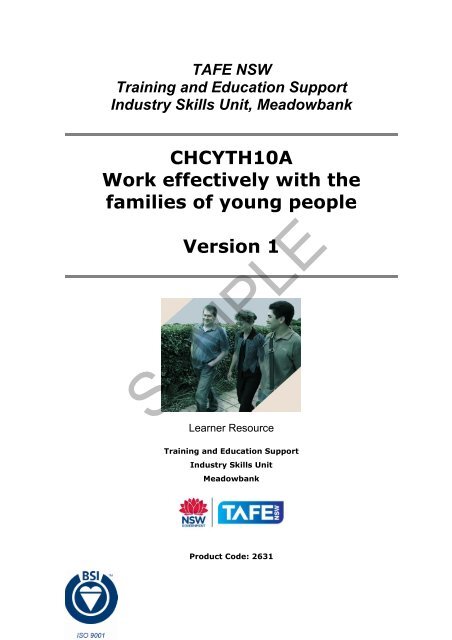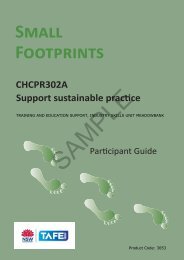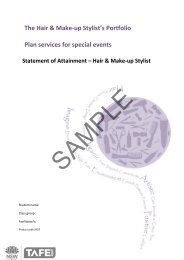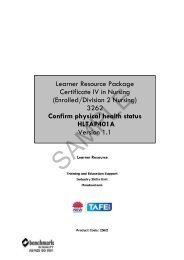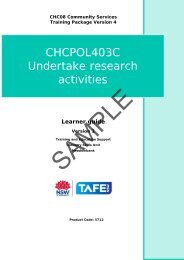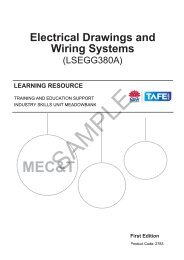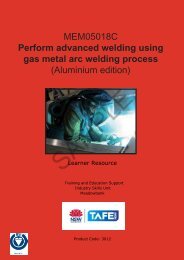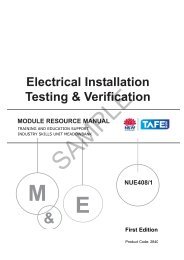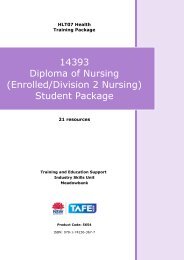TAFE NSW Training and Education Support Industry Skills ... - vetres
TAFE NSW Training and Education Support Industry Skills ... - vetres
TAFE NSW Training and Education Support Industry Skills ... - vetres
You also want an ePaper? Increase the reach of your titles
YUMPU automatically turns print PDFs into web optimized ePapers that Google loves.
<strong>TAFE</strong> <strong>NSW</strong><strong>Training</strong> <strong>and</strong> <strong>Education</strong> <strong>Support</strong><strong>Industry</strong> <strong>Skills</strong> Unit, MeadowbankCHCYTH10AWork effectively with thefamilies of young peopleVersion 1SAMPLELearner Resource<strong>Training</strong> <strong>and</strong> <strong>Education</strong> <strong>Support</strong><strong>Industry</strong> <strong>Skills</strong> UnitMeadowbankProduct Code: 2631
CHCYTH10A Work effectively with the families of young people V1iAcknowledgments<strong>TAFE</strong> <strong>NSW</strong> <strong>Training</strong> <strong>and</strong> <strong>Education</strong> <strong>Support</strong> – <strong>Industry</strong> <strong>Skills</strong> Unit, Meadowbankwould like to acknowledge the support <strong>and</strong> assistance of the following people inthe production of this resource package:Writers/CompliersBerenice MurphyTeacher –Illawarra Institute<strong>TAFE</strong> <strong>NSW</strong>Michael RaymentTeacher – Hunter Institute<strong>TAFE</strong> <strong>NSW</strong>Project Manager/ReviewerKarin Rule<strong>Education</strong> Program Manager<strong>Training</strong> <strong>and</strong> <strong>Education</strong> <strong>Support</strong><strong>Industry</strong> <strong>Skills</strong> Unit, Meadowbank<strong>TAFE</strong> <strong>NSW</strong>EnquiriesEnquiries about this <strong>and</strong> other publications can be made to:<strong>TAFE</strong> <strong>NSW</strong> <strong>Training</strong> <strong>and</strong> <strong>Education</strong> <strong>Support</strong> – <strong>Industry</strong> <strong>Skills</strong> Unit, MeadowbankLocked Bag No. 6MEADOWBANK <strong>NSW</strong> 2114SAMPLETel: 02-9942 3200 Fax: 02-9942 3257Meadowbank, <strong>TAFE</strong> <strong>NSW</strong>.T:\aaResources & Promo\Ed Delivery\Final copy resources\Community Services\from May2007\CHCYTH10A_LLP_V1© The State of New South Wales, Department of <strong>Education</strong> <strong>and</strong> <strong>Training</strong>, <strong>TAFE</strong> <strong>NSW</strong> <strong>Training</strong> <strong>and</strong><strong>Education</strong> <strong>Support</strong>, <strong>Industry</strong> <strong>Skills</strong> Unit, Meadowbank, 2009Copyright of this material is reserved to <strong>TAFE</strong> <strong>NSW</strong> <strong>Training</strong> <strong>and</strong> <strong>Education</strong> <strong>Support</strong>, <strong>Industry</strong> <strong>Skills</strong>Unit, Meadowbank, <strong>TAFE</strong> <strong>NSW</strong>. Reproduction or transmittal in whole or in part, other than for thepurposes of private study or research, <strong>and</strong> subject to the provisions of the Copyright Act, is prohibitedwithout the written authority of <strong>TAFE</strong> <strong>NSW</strong> <strong>Training</strong> <strong>and</strong> <strong>Education</strong> <strong>Support</strong>, <strong>Industry</strong> <strong>Skills</strong> Unit,ISBN: 978-0-7348-9036-8
CHCYTH10A Work effectively with the families of young people V1iiiTABLE OF CONTENTSSECTION 1 INTRODUCTION ........................................................................... 11. GENERAL INTRODUCTION ................................................................................ 12. USING THIS LEARNING GUIDE ........................................................................... 13. UNIT DESCRIPTION ......................................................................................... 34. LEARNING TOPICS .......................................................................................... 35. UNIT ELEMENTS AND PERFORMANCE CRITERIA .................................................. 56. LEARNING OUTCOMES .................................................................................... 8SECTION 2 ASSESSMENT REQUIREMENTS ................................................ 9SECTION 3 RESOURCE LIST ....................................................................... 11SECTION 4 GLOSSARY ................................................................................ 17TOPIC 1. ESTABLISH RELATIONSHIP WITH FAMILY MEMBERS ............ 231.1 USING COMMUNICATION STRATEGIES TO GATHER INFORMATION .................... 241.2 PROVIDING INFORMATION THAT IS FACTUAL AND CLEAR ............................... 281.3 CHANGES TO BEHAVIOUR AND RELATIONSHIPS ............................................ 311.4 MAINTAINING CLEAR, ETHICAL AND HONEST RELATIONSHIPS ......................... 401.5 ENCOURAGING PERSONAL REFLECTION ...................................................... 471.6 IDENTIFY OBSTACLES TO PROFESSIONAL ..................................................... 51TOPIC 2. EXCHANGING INFORMATION ABOUT NEEDS AND RISKS ...... 592.1 THE SELECTION OF EFFECTIVE COMMUNICATION TECHNIQUES ...................... 592.2 MONITORING THE BEHAVIOUR AND MOOD OF CLIENTS .................................. 632.3 PROVIDING CLEAR, RELEVANT AND SUITABLE INFORMATION ......................... 672.4 ANALYSE YOUR VALUES FOR THEIR IMPACT ON SERVICE PROVISION .............. 71TOPIC 3 MUTUAL APPROACHES TO ADDRESSING ................................... 753.1 MEETING CLIENT NEEDS AND EXPECTATIONS. .............................................. 753.2 CONSISTENCY WITH POLICIES, OBJECTIVES AND SERVICE OUTCOMES ............ 793.3 NEGOTIATE GOALS AND INDICATORS OF ACHIEVEMENT. ................................ 823.4 PLAN A STRUCTURED TIMED SEQUENCE OF ACTIVITIES ................................. 873.5 CONSULTATION OF TEAM MEMBERS FOR FEEDBACK. .................................... 893.6 IDENTIFYING RESOURCES ACCORDING TO PRIORITIES AND AVAILABILITY ........ 94SAMPLETOPIC 4 RESPOND TO FAMILY CONCERNS ABOUT YOUNG PERSONS .. 974.1 USING A RANGE OF COMMUNICATION STRATEGIES ....................................... 974.2 IDENTIFY AND PRIORITISE SHORT AND LONG TERM IMPLICATIONS .................. 994.3 PROVIDE UNDERSTANDABLE INFORMATION TO FAMILY MEMBERS. ................ 1024.4 ENCOURAGE COMMITMENT, COOPERATION AND MUTUAL ACTION ................. 1054.5 CHECKING INFORMATION ABOUT FAMILY MEMBERS .................................... 1104.6 ENCOURAGE MEMBERS OF THE FAMILY TO TAKE RESPONSIBILITY ................ 1124.7 CAREFUL SELECTION OF THE LOCATION OF CLIENT MEETINGS ..................... 1144.8 MAINTAINING POSITIVE DIRECTION, COOPERATION, ACHIEVEMENTS ............. 119FEEDBACK TO LEARNING ACTIVITIES ......................................................... 123
CHCYTH10A Work effectively with the families of young people V1 23TOPIC 1ESTABLISH RELATIONSHIP WITH FAMILYMEMBERSThe term family is difficult to define because there are many types. However, abroad definition of family is two or more people who consider themselves relatedby blood, marriage <strong>and</strong>/or adoption <strong>and</strong> live together or have lived together. Manyyoung people who inhabit the same household often view each other as familyespecially in the adolescent period.Family members or caring <strong>and</strong> responsible adult/community members can play avaluable role in the positive mentoring of a young person life particularly if theyoung person is experiencing conflict within the immediate or extended family.In the transition to adulthood a positive, caring <strong>and</strong> functional family plays animportant role in the adolescent‘s life in. This can occur through the following:Providing a safe <strong>and</strong> secure base in which boundaries can be tested inrelative safetyThe family can be supportive of the young person as the undertake thejourney to become physically <strong>and</strong> emotionally independentProviding stability <strong>and</strong> a relative safety base to explore their changingbeliefs, values, ideas <strong>and</strong> environmentsProviding reassurance, support <strong>and</strong> unconditional loveDiversity in familiesCultural diversity influences the structures <strong>and</strong> practices of families. Diversity inthe areas of clothing, religion, language, cultural beliefs <strong>and</strong> values has a profoundimpact on almost every aspect of family life.For example, research suggests that recent immigrants have brought with them acultural tradition of living in a large, extended family system. The lives of Australianfamilies are also profoundly influenced by patterns of discrimination <strong>and</strong> economicinequality. For example the family life of Indigenous peoples is conditioned bylong-st<strong>and</strong>ing patterns of economic <strong>and</strong> social isolation <strong>and</strong> marginalisation.SAMPLEIn Australia there has been an increase in one-parent families. This is due in partto an increasing divorce rate <strong>and</strong> the sharp increase in single motherhood sincethe 1980‘s. Most single parent headed families are female <strong>and</strong> are more at risk ofliving in poverty as women still earn less then men. Research demonstrates thatchildren from single headed families are more likely to have issues <strong>and</strong> orproblems with educational achievement, health, behaviours <strong>and</strong> relationships.Blended families are an increasing factor in family life in AustraliaThis topic discusses how to build rapport with family members by communicatingappropriately, providing factual information <strong>and</strong> working within an ethicalframework.Developed by <strong>TAFE</strong> <strong>NSW</strong> <strong>Training</strong> <strong>and</strong> <strong>Education</strong> <strong>Support</strong> – <strong>Industry</strong> <strong>Skills</strong> Unit, Meadowbank© 2009 <strong>TAFE</strong> <strong>NSW</strong>
24 CHCYTH10A Work effectively with the families of young people V11.1 Using communication strategies to gather informationAs workers we communicate with a wide range of people from many differentsocio-economic backgrounds <strong>and</strong> cultures. When we are communicating withclients <strong>and</strong> communities we are doing so in the context of a helping relationship.A helping relationship is a relationship that is formed for the purpose of oneperson (the Community Services <strong>and</strong> Health <strong>Industry</strong> (CS&HI) worker) helpinganother (the client) <strong>and</strong> at times others, (such as the client‘s family) with a need orconcern. As a result the helping relationship is one-sided in that it focuses on theneeds <strong>and</strong> issues of people (client-focused), is time limited <strong>and</strong> has clearboundaries.The most important thing to remember when communicating within the context ofa helping relationship is that it is up to us as workers to use our interpersonalcommunication skills to connect with a client, set them at ease, find out what theirneeds are <strong>and</strong> provide them with information. We should be doing all the work toestablish rapport <strong>and</strong> must not leave it up to the client or community memberseeking assistance.Activity 1.1 – A helping relationshipThink of a time in your life when you were in a situation when you needed helpfrom another person. What did they do that made you feel they cared?SAMPLEDeveloped by <strong>TAFE</strong> <strong>NSW</strong> <strong>Training</strong> <strong>and</strong> <strong>Education</strong> <strong>Support</strong> – <strong>Industry</strong> <strong>Skills</strong> Unit, Meadowbank© 2009 <strong>TAFE</strong> <strong>NSW</strong>
CHCYTH10A Work effectively with the families of young people V1 251.1.1 Communication methodsCommunication can be verbal, non-verbal or written.Verbal communication is generally referred to as relating to the words that arebeing said while non-verbal communication includes all the messages that aresent not using words.Non-verbal communication includes:facial expressionseye contacttone of voicevolume of speechrate of speechh<strong>and</strong> movements (gestures)body movementsposturespatial distance (how close we st<strong>and</strong> or sit to someone)touchdress/presentationSAMPLENonverbal communication tips (Kendra Van Wagner: 2007)Developed by <strong>TAFE</strong> <strong>NSW</strong> <strong>Training</strong> <strong>and</strong> <strong>Education</strong> <strong>Support</strong> – <strong>Industry</strong> <strong>Skills</strong> Unit, Meadowbank© 2009 <strong>TAFE</strong> <strong>NSW</strong>
26 CHCYTH10A Work effectively with the families of young people V1Messages usually contain both verbal <strong>and</strong> non-verbal components with the verbalpart of the message conveying the content or information <strong>and</strong> the non-verbal parttelling the receiver what the content means to the person talking. If there is ever amismatch between the verbal <strong>and</strong> non-verbal message the receiver of thecommunication is more likely to focus on the non-verbal signals that they arereceiving. This is because as receivers of messages we are trying to work outwhat someone means when they are communicating with us <strong>and</strong> body language ismore likely to give us the clues that we are looking for.The problem with body language, or non-verbal communication, is that it is easy toget it wrong. We usually assume that we know what it means when someone, forexample, won’t look at us when they are talking <strong>and</strong> so make assumptions thatthey are lying to us when in fact they might be quite depressed or the behaviour isculturally defined.The tendency that people have as receivers of messages to not check outassumptions leads to many problems in relationships <strong>and</strong> interactions.1.1.2 Attending behaviourAttending behaviour has two steps:1. being ready to listen2. showing that you are listeningBeing ready to listen involves “letting go” of your own thoughts <strong>and</strong> feelings <strong>and</strong>being prepared to focus on the person who is talking to you. Showing that you arelistening involves a range of active listening skills <strong>and</strong> non-verbal cues. Attendingbehaviours focus on the non-verbal cues that are involved in the listening process.The most common cues to show attending behaviour include nodding our heads,maintaining eye contact, <strong>and</strong> using minimal encouragers – the “Mm”, “Mm-hmm”,“right”, Ah-ha” types of noises. Gerard Egan in his book The Skilled Helper (1998)talks about adopting the SOLER position.Effective Listening - SOLERS = face the person squarelyO = open upper bodyL = slight forward leanE = eye contactR = relaxed posture (arms not crossed, etc).SAMPLECommunication cues may be different for some people with specific disabilityconditions.Developed by <strong>TAFE</strong> <strong>NSW</strong> <strong>Training</strong> <strong>and</strong> <strong>Education</strong> <strong>Support</strong> – <strong>Industry</strong> <strong>Skills</strong> Unit, Meadowbank© 2009 <strong>TAFE</strong> <strong>NSW</strong>


